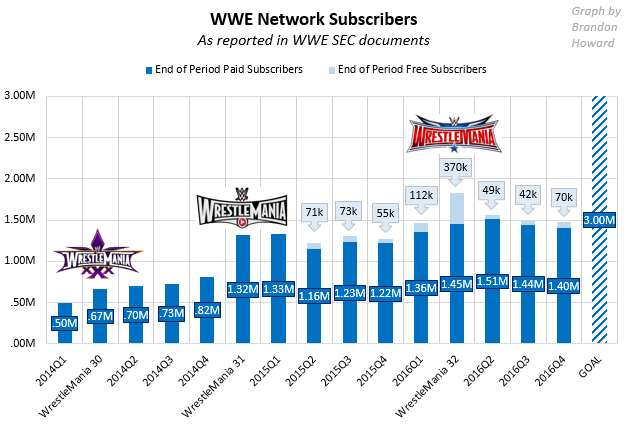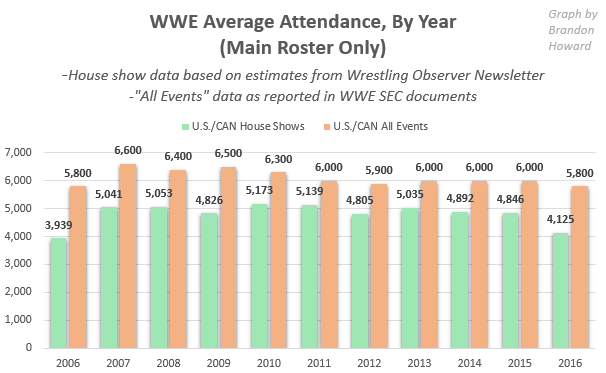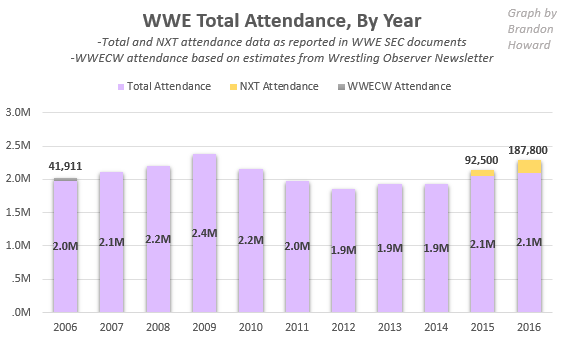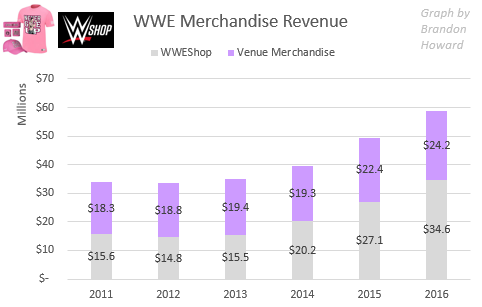WWE Network
WWE's stated 3 million to 4 million subscriber goal for the WWE Network seems more and more like a fantasy. The company itself acknowledges 2017's year-over-year growth of subscribers will be less than 2016's as the Network's maturity slows and the subscriber count sits at 1,500,000 following Royal Rumble as of the end of January.

The Network metric to look at that most concisely determines how much money the service generates in a given year is average subscribers throughout the year. In 2015 that number was 1,139,000. In 2016 it was up 24% to 1,418,000. So we can expect year-over-year growth at a rate substantially lower than 24% in 2017. Let's say the Network grows at a rate of 12%: that would put average subs throughout the year at 1,588,000. If Network spending remains exactly the same in 2017 as it was in 2016, then the Network would generate $48 million.
While Network subs will likely increase year-over-year, I predict PPV revenue will also continue to marginally decrease year-over-year. ($83 million in 2013, $45 million in 2014, $21 million 2015, $13 million in 2016). The continued marginal decline in PPV revenue and OIBDA will largely offset increases in revenue and OIBDA from additional Network subscribers, resulting in the company reporting similar or only a slightly higher figure for "Total Network" (Network+PPV) OIBDA. In other words, I think the Network will be at best only slightly more profitable in 2017 despite an increase in subscribers, and the service will fully mature, whether this year or next year, with a subscribership that arguably won't cover the OIBDA of a hypothetical model without the OTT service and where PPV events were offered on traditional PPV and iPPV.
During the company's Q4 conference call Thursday CFO George Barrios implied WWE will again offer free trials to new users going into WrestleMania this year. The company may attempt to reach 2 million free+paid subscribers by the morning after WrestleMania, when Network numbers will be publicly reported again. Last year the company reported 1,824,000 subscribers the day after WrestleMania, although 1,454,000 were paid; the other 370,000 were free trial subscriptions. I think hitting a total of 2 million free+paid subscribers on the day after WrestleMania 33 is possible. The company only needs a 10% increase in free+paid post-WrestleMania from last year to hit 2 million. However due to the age of the service and the fact that new markets last year won't be new this year, I'd expect free+paid subs will fall short of 2 million, and paid subs after WrestleMania will be around 1,600,000 with free subs short of the 400,000 needed to hit the symbolic 2 million mark.
Going forward into 2018 and 2019 I'd expect Network subs to become flat year-over-year and for us to get a pretty clear idea of what the Network's steady state is: probably somewhere above 1.5 million paid subs but below 2 million. The steady state would come just as WWE needs to renegotiate its major television rights contracts: its largest source of revenue and profit. With a steady state Network, the company should be able to more clearly strategize for whatever the media landscape brings in 2019. As Barrios has said in public talks, "the crystal ball is cloudy" still when it comes to predicting TV rights contracts even a few years into the future.
WWE's revenue and OIBDA projections are reliable. The most uncertain factor in WWE's business is the Network, whose finances are dependent on subscriptions that may come or go. The company has proven able to give good projections of subscriber counts each quarter, which have been accurate within a few percent (i.e., within a few tens of thousands of subscribers). I see their $100 million OIBDA projection for 2017 as reliable.
While revolutionary and exciting for fans, the WWE Network isn't yet a superior business to pay-per-view in my view. Even if with generous assumptions about what PPV, Home Entertainment and Digital Media would look like today if there was no Network, the Network would only be making a few million more each year compared to a PPV-only scenario. The Network cost the company $30 million to $40 million on initial startup, besides the other businesses it cannibalized.
Depending on what you think a PPV-only alternate reality would look like, the company still needs the Network to make back $30 million to $70 million in losses.
That doesn't even factor in the uncertain amount of money the company lost due to, by Vince McMahon's own admission, the Network's launch negatively affecting WWE's leverage in negotiating TV rights in 2014. Although the company overall is strong, at the current rate, it will be many years or multiple decades before the Network pays off its opportunity cost, if ever.
In hindsight, it likely would've been wiser to keep the big three PPVs (Royal Rumble, WrestleMania and Summerslam) or just WrestleMania exclusive to pay-per-view while putting the rest on the Network. Keeping WrestleMania exclusive to PPV was speculated at one time to be the plan sometime before the Network was ultimately launched to include all PPV events.
As the Network’s subscriber ceiling nears and appears well below 3 to 4 million paid subscribers, it’ll be interesting to see if WWE drops that goal from its presentations and how executives answer questions relating to the service’s ultimate subscriber potential. The goal conspicuously wasn't mentioned in the earning's report Thursday.
Live Events
Average attendance was down but not alarmingly so. WWE ran more events than last year, even before counting NXT events. This along with higher average ticket prices and the biggest gate in pro wrestling history (WrestleMania 32), gave the company even higher revenue and profits when it comes to live events.
Preliminary research I did based on estimates of individual events reported in the Wrestling Observer Newsletter (and collected by Chris Harrington) showed main roster house show attendance in the U.S. and Canada at its lowest point since 2006.

Perhaps house show attendance continued to tick down due to a more discerning fan who knows little of consequence happens at house shows. Perhaps it declined due to the fact John Cena appeared on only 17 house shows in this region. Nonetheless total main roster attendance was at its highest since 2010.
That 2016 number gets even higher if we add in NXT's 187,800 in paid attendance for the year.

I'd expect average attendance to stay at its current level or decrease slightly as WWE continues running even more events. 2017 will be an entire year of running separate house show crews with the brand split. House show rosters were only separated for the last few months of the year in 2016, so I'd expect even more main roster live events and a similar number of NXT events in 2017, each with similar or slightly higher average ticket prices generating increases in revenue and OIBDA.
Given the high ticket prices of WrestleMania 33 in Orlando compared to the past two years, I'd expect this year's even to rival the all-time record set by WrestleMania 32 last year of $17.3 million. The stadium in Dallas for WrestleMania 32 has a larger capacity than the stadium in Orlando for WrestleMania 33. Last year's event drew somewhere around 80,000 paid. The most recent WrestleMania in Orlando, in 2008, drew 63,100. Even with that much difference in capacity, ticket prices have increase enough to convince me the WrestleMania 32 record may be within reach. The lowest and highest ticket prices for this year's event are respectively $160 and $3,000. Last year the range was $42 to $2,360; $39 to $2004 the year before that. Average ticket prices for WrestleMania 31 and 32 were about $215. If the average ticket price for WrestleMania 33 is as high as $300 and the event draws 60,000 paid attendees, then the gate would be $18 million: a new pro wrestling record.
Merchandise
I've often used increasing merchandise finances as one piece among multiple pieces of supporting evidence that WWE's popularity is not genuinely decreasing despite declining TV ratings. This year's annual report explained increased merchandise sales in the WWEShop segment were due to "additional distribution channels, including in international territories, continued marketing efforts and a broader assortment of products offered".
Nonetheless if WWE's popularity was genuinely decreasing we might see these finances remain flat or decrease, which we don't. Additionally, if the number of WWE fans were increasing while merchandise finances simultaneously decreased, we should see merchandise revenue per capita increase, which we also don't.

Venue Merchandise purchases per capita increased year-over-year by 3%, according to the annual report. Meanwhile that segment's revenue increased 8%. The increase in the segment's revenue being higher than the increase in revenue per capita suggests an increase in the portion of attendees buying merchandise at an event. The report also stated revenue per online order was down 3%. These facts discredit the notion that WWE is getting more money out of each fan when it comes to merchandise purchases.
Big Wheel Keeps Turning
Even with John Cena missing nearly half the year and working a reduced house show schedule after that, WWE still increased in profitability overall, in live event profits and in Network subscribers.
That seems like proof of Vince McMahon’s statement during Thursday’s conference call: “[T]here is no one talent that makes this big wheel keep on turning.”
He used that phrase again when talking about the RAW-SmackDown brand extension: “Well, as far as the brand extension is concerned it’s working extremely well, that’s working exactly like we thought it would... [Building up viewership for SmackDown] just in and of itself is what we are trying to do as well and are doing and more viewers come to SmackDown, then more viewers elect to watch RAW as well. So it’s a big wheel that keeps on turning. So that’s our strategy.”
No one performer should make a significant difference to WWE, seems to be the philosophy. This is supposed to be soothing to investors; they don’t have to worry about volatility if one star gets injured or leaves the company. And as evidenced last year, WWE as we know it really does function that way. Cena can go down, a crop of other injuries can pile up and the company will still put on its biggest money show ever.
Yes, the brand is the draw. Talent are spokes on the wheel; some spokes stronger than others but spokes nonetheless; no one talent can be big enough to strongly change the speed of the wheel alone; the wheel is just too gigantic and corporate.
While investors removed from the history of the pro wrestling business might not know better, I’m still of the belief a true superstar, greater in magnitude than Cena or any other currently, could emerge who increases business across virtually every metric and business segment. In previous eras when albeit the company was a simpler business, Hulk Hogan, Steve Austin and The Rock did for the company what neither Cena nor any other since 2001 has done.
WWE’s creative vision, headed by McMahon himself, continues to mitigate the emergence of any true difference-making superstar.
Maybe it’s a comforting story those in the company tell themselves: that WWE is so much more diversified as a business now that there isn’t any one star who can possibly come along and change things like Hogan or Austin did -- that the business has just changed and the machine is insurmountably too big for a star to make a difference like that now.
Those who have followed WWE programming over the last ten or fifteen years know the company has missed the mark year after year when it comes to getting the most out of talent in terms of getting them to connect with the audience -- not just with hardcore fans or fickle fantasy bookers who complain online; the company has failed to make almost any of its stars seem special for anything but a fleeting amount of time. Aging stars who appear infrequently seem more like special attractions than full-timers -- less because they were from a more popular era and more because they’re less exposed to the hazards of WWE’s neutralizing weekly programming which is booked in a format with the old marks of a wrestling war that ended 16 years ago.
To WWE's credit SmackDown improved in this regard last year. Overall the main roster creative still lacks in forging genuine emotional connections. It disregards reality, history and continuity to its convenience. RAW is still centered around a heel authority figure, Stephanie McMahon, who no other character can outwit and who gets supposed heel heat to deflect genuine resentment towards the company.
Often rather than cheering faces and booing heels, fans do the opposite. Not because TV events are held in "heel towns" but because the creative direction doesn't have a relatable moral conscience. Babyfaces often don’t behave decently. Friendships and romantic relationships almost exclusively involve manipulative bad guys. Main roster programming reads like it’s written by teenagers who has neither yet developed a sense of right and wrong nor sincere relationships of their own.
This isn’t just an aesthetic issue but an economic one. Emotional connections are what made fans want to buy a ticket to see Hogan in the 80s or tickets and PPVs to see Austin in the 90s, and spread word of mouth among friends -- word of mouth that would conceivably spread even faster in an age of social media. Emotional connections, albeit looser ones, still are what make people spend money on WWE, but the company's true potential is still locked up behind often stubborn, obsolete and fickle creative which prevents stars from becoming bigger stars who develop deeper connections that would make a lot more people want to buy more tickets, shirts or Network subscriptions in 2017. Expect none of this to change as long as Vince McMahon leads creative, and expect him to lead creative as long as he's physically able.
Follow Brandon on Twitter @adecorativedrop. He can be contacted by email at [email protected].




